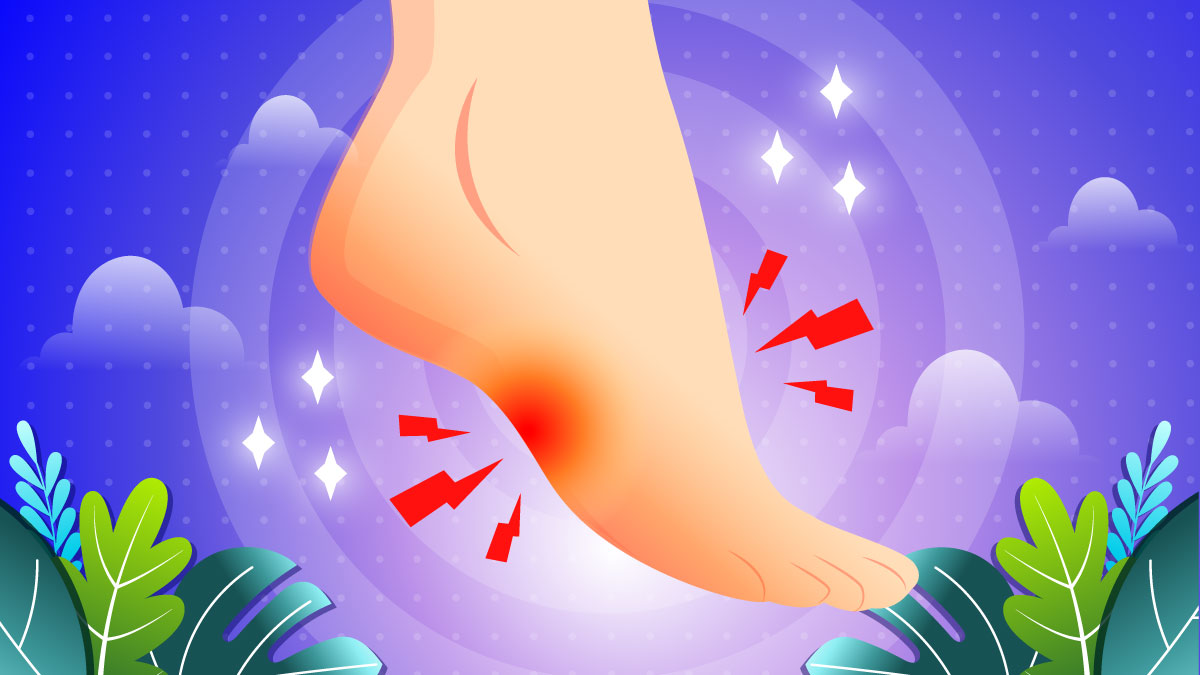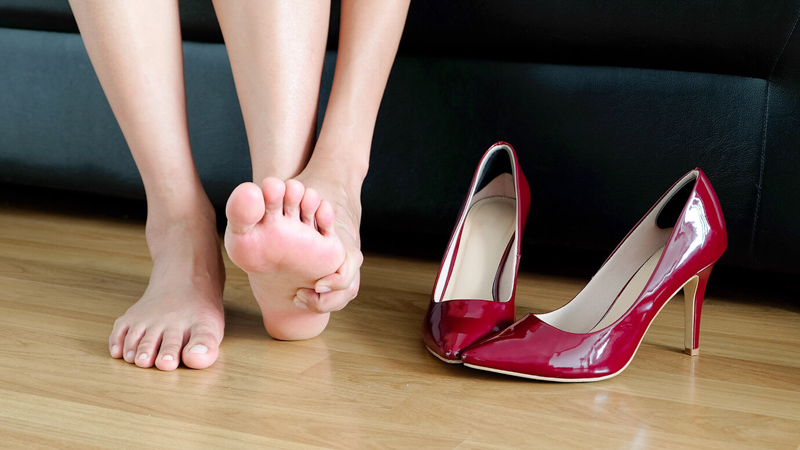CBD Oil For Plantar Fasciitis: Does It Help With Foot Problems?

Some people experience excruciating pain in their heels or in the bottom of their feet. This uneasiness usually increases as we put weight on our feet. The pain may be because of different health issues, but sometimes it is due to plantar fasciitis. Plantar fasciitis is simply the technical term for the most common type of heel pain.
Prolonged pain can significantly reduce our energy and productivity levels. If the pain is not managed efficiently, it can eventually lead to severe side effects. CBD is a potential treatment for pain and discomfort. This amazing compound has the ability to interact with our body at the molecular level and can help it perform better even in the face of pain caused by plantar fasciitis.
What Is Plantar Fasciitis?
Plantar fasciitis is known to be the most common type of heel pain that may occur due to various reasons. The heel bone is connected to our toes through a band of tissues. Inflammation in this thick band can cause stabbing pain, especially during the first step in the morning. The pain usually goes away as we take a few steps. However, it may return if we sit or stand for a prolonged period of time. Plantar fasciitis is a common condition for runners and for people who are overweight.
What Are the Symptoms of Plantar Fasciitis?
Plantar fasciitis is typically associated with excruciating pain near the heel area of the foot. The pain can get worse after a workout session or excessive physical activity. The stabbing pain is usually experienced shortly after a long rest period.
What Are the Causes of Plantar Fasciitis?
The arch of our foot is supported by a bowstring called the plantar fascia that absorbs the shock we experience as we walk. Excessive stress and tension of the bowstring can cause a tear which will cause inflammation and irritate the muscles in your foot. Risk factors of plantar fasciitis include age, obesity, foot mechanics, and the types of exercises you participate in.
What Is CBD?
CBD, or cannabidiol, is one of the most popular exogenous cannabinoids extracted from the Cannabis Sativa plant or from industrial hemp. Unlike its chemical cousin, THC or tetrahydrocannabinol, CBD is non-psychoactive and does not cause euphoric effects. Research has shown that CBD is quite effective in improving the overall health of the human body as it can promote homeostasis and help in maintaining overall balance. CBD products with less than 0.3 % THC are legal federally in the United States and can be used for various purposes. It is available in a wide range of products that can be used according to personal preferences and your needs.
What Is CBD Used for?
CBD works by interacting with the human endocannabinoid system, which is responsible for maintaining homeostasis. The endocannabinoid system carries out a long list of physiological processes that are essential in keeping the body working in its optimal state. CBD can interact with the CB2 receptors of the endocannabinoid system. CB2 receptors are usually concentrated in the peripheral nervous system. CB2 receptors perform some of the most basic physiological functions that include managing inflammation, pain, neurological activity, and immune function.
CBD can be used to promote the activity of CB2 receptors and reduce pain and inflammation, and neurological dysfunction. It can also help in boosting overall mental health by reducing your stress and anxiety levels.
Benefits of CBD for Plantar Fasciitis

Many studies show that CBD can be helpful for chronic pain or medical conditions that cause pain in muscles and joints. However, there are no studies that directly explain the effect of CBD on plantar fasciitis. But CBD can be helpful in reducing pain and discomfort caused by a damaged bowstring in your foot. The interaction of CBD with CB2 receptors helps in relieving pain and reducing inflammation. Since inflammation is directly related to pain, a decrease in inflammation also reduces discomfort and uneasiness and allows you to walk in a much more comfortable manner.
Pain Relief
The most prominent symptom of plantar fasciitis is stabbing pain in the heel or in the bottom of the foot. CBD can decrease pain perception because of its nociceptive effects.
Anti-inflammatory Properties
Even though inflammation is a positive and helpful response of the body towards any injury, excess inflammation can cause potential damage to the body. CBD can suppress the response of immune cells and reduce inflammation to help the damaged cells heal quickly and eventually make you feel more at ease.
Appetite Suppression
Obese people have a higher risk of damaged muscles. Some people may have obesity because of an underlying health condition, but many people suffer from this condition because of overeating or in taking unhealthy calories. Research has shown that CBD can also help in reducing your appetite, which can be extremely valuable in weight management.
Swelling
Swelling and redness are the most common effects of inflammation. Since CBD is quite helpful in reducing inflammation, it can also significantly reduce the physical effects of the body’s natural response, including swelling and redness. This promotes easier movement, better sleep, and a more natural appearance.
How Does CBD Work for Foot Pain?
Research has shown that CBD is quite effective in reducing localized pain in different parts of the body, including the feet. Topical or transdermal application of CBD can reduce the symptoms of inflammation such as swelling, redness, and pain. Rubbing CBD products directly on the affected area helps it to heal the damaged cells quickly.
Oral CBD doses are also effective but may produce the desired results only after a few hours of its intake. Topical application of CBD usually produces instant results, and you can feel relief with a few minutes of application.
Side Effects of CBD
CBD is generally safe and does not cause any severe side effects.
The most common side effects caused by CBD include:
- Reduced appetite
- Fatigue
- Drowsiness
- Dry mouth
- Diarrhea
These side effects usually fade off on their own and do not require any medical attention. CBD is also known to interact with some over-the-counter medications, such as blood thinners. It is important to avoid using CBD with most prescription medications. Always consult your healthcare practitioner before taking CBD if you are already on some medicines. Also, your CBD products should be reliable and pure so that there are no contaminants in the product which can cause harmful effects on your health and body, particularly if you are already taking other medication.
How to Use CBD for Plantar Fasciitis?

CBD is available in different types of products that can be used for relief from chronic pain caused by an injured heel. Here are some of the most common types of CBD products available on the market today.
CBD Vapes
CBD vapes are very common these days and can be used for relief from the symptoms of plantar fasciitis. Vaping is safer than smoking and produces quicker results as compared to other CBD delivery methods. However, if you are already suffering from any lung-related or breathing issues, it is recommended to avoid using CBD vapes and switch to other types of CBD products.
CBD Topicals
CBD topicals are the most effective types of CBD products that can be used to seek relief from the symptoms of plantar fasciitis. You can easily find CBD topical products, such as balms, creams, lotions, and salves. Our skin possesses CB2 receptors, so your CBD dose can directly interact with these receptors in the skin and produce quicker results.
CBD Oil
CBD oil is another popular way to intake CBD. Since CBD you ingest will have to go through metabolic processing in the body, it usually takes 4 to 5 hours before producing the desired result.
CBD Gummies
CBD gummies may be the tastiest and most convenient way to take your daily CBD dose. Each gummy contains a specific quantity of CBD, which can be taken with other vitamin supplements. These CBD gummies have different flavors like orange, strawberry, and mango, among many others in the market today.
Dosage
There is no universal dose of CBD that is equally helpful for everybody. Each one of us has to find the dose that is best for our health condition. In the process of finding the right dosage, we should be very careful and observant about any positive and negative changes occurring in our bodies. It is recommended to begin with the smallest dose possible and increase it gradually if it does not seem to produce the desired results. You can begin with taking 5mg of CBD per day and increase it as necessary. Note that our body can tolerate up to 1500 mg of CBD per day.
Key Takeaways on Using CBD Oil for Plantar Fasciitis
CBD is undoubtedly helpful for reducing pain caused by plantar fasciitis. However, be careful if you are already taking any other medicines. It is important to remember that CBD should not be considered as a sole treatment option and if your condition worsens, consult your doctor immediately.
Make sure to go for safe CBD products that come with a certificate of analysis showing the exact ingredients and their quantity. All premium CBD products should be third-party lab tested. So, play it safe and choose quality products from established companies for the best results in easing the pain from plantar fasciitis.
References Used:
- Crivelaro do Nascimento, G., Ferrari, D. P., Guimaraes, F. S., Del Bel, E. A., Bortolanza, M., & Ferreira-Junior, N. C. (2020). Cannabidiol increases the nociceptive threshold in a preclinical model of Parkinson’s disease. Neuropharmacology, 163, 107808. [1]
- Iffland, K., & Grotenhermen, F. (2017). An Update on Safety and Side Effects of Cannabidiol: A Review of Clinical Data and Relevant Animal Studies. Cannabis and cannabinoid research, 2(1), 139–154. [2]